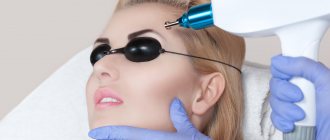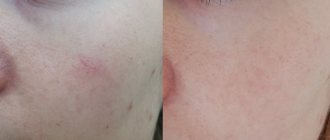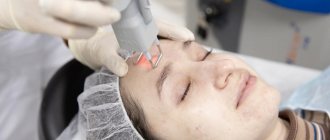Date of publication: 03/16/2020 2929
Removal of permanent tattoos is necessary not only in case of an unsuccessful procedure. Often you just need to remove the remnants of the old permanent in those places where it cannot be covered with a new one. We are lucky: modern methods of tattoo removal are much more gentle than they were at least 10 years ago. At that time, microdermabrasion was popular - mechanical peeling, in which pigment was literally cleaned out of skin cells. Of course, all this was painful and took a very long time to heal. Now there is no point in suffering like this, because there are more progressive and comfortable ways to remove tattoos: chemical and laser. Although some salons still offer good old microdermabrasion - apparently, for those who love the thrill.
How many sessions do you need to attend?
No doctor has a specific answer to this question; each situation is individual. Typically, the laser removes pigment in 3-4 sessions or more. Some patients require 6-12 procedures.
Factors influencing the number and intensity of procedures:
- The amount of pigment in the skin of the eyelids;
- Chemical composition of paint;
- The depth to which the pigment is driven;
- Age and uniformity of tattooing;
- Density of paint in the skin;
- The presence of connective tissue;
- Injury to the skin of the eyelids;
- Patient's age.
The dye is not always removed 100%. Thai and acrylic paints are considered difficult. This type of permanent makeup requires a longer course.
Recovery period, possible complications
Laser pigment removal technology is safe and low-traumatic. In some cases, complications may arise due to incorrect selection of the laser and the intensity of its action, as well as due to non-compliance with the procedure protocol.
Of the following nature:
- swelling, erythema of the treated area;
- the appearance of burns, hematomas, scars;
- pigmentation;
- development of allergies and inflammation.
You need to know that the device is equipped with a metal handpiece, so the appearance of a small hematoma, slight swelling and redness is normal.
All standard negative manifestations quickly pass if you follow the rules of post-procedure care, namely:
- Avoid exposure to open sun and apply a product with a high protection factor before going out.
- Avoid drinking alcohol, smoking, avoid going to the bathhouse, solarium, swimming pool,
- Avoid using decorative cosmetics and skin care products containing alcohol or aggressive chemical components.
- Treat with wound healing agents for 5-7 days.
- If crusts form, do not pick them off.
To minimize the healing time, cosmetologists recommend limiting minor mechanical impact on the treated areas, as well as applying Bepanten ointment, before washing the skin with baby soap and blotting with a towel.
Correct removal of unsuccessful or annoying tattoos of eyebrows, eyes or lips with a laser allows you to restore aesthetics to your image. To achieve the desired result and eliminate the risk of complications, the procedure must be carried out by a highly qualified specialist using certified equipment.
Rehabilitation after the procedure
Refraining from visiting the pool, bathhouse and training is required. For 14 days, exclude the solarium and the beach.
You must follow the rules of care:
- Moisturize the eyelids with creams with dexpanthenol (Panthenol, Bepanten, Teva);
- If there are crusts, do not tear them off;
- Be sure to use sunscreen for 2-4 months after removal;
- Peels, masks, scrubs are excluded.
The eyes do not suffer after laser tattoo removal. The skin of the eyelids should not look like the photo above.
In what cases is it necessary to remove eyelid tattoos?
Keep in mind! There are several good reasons to remove tattoos:
- The result does not always look natural , especially if done unprofessionally. Moreover, today this method of decorating oneself is no longer considered attractive, so the first reason is a return to a natural image.
- Sometimes the result turns out to be unsuccessful due to the fault of the artist: the wrong shade appears, you don’t like the shape of the eyelids, the paint applied unevenly . Such errors cannot be corrected in all cases; they can only be deleted.
- Women are sensitive to changes in fashion trends, and if something is no longer fashionable , they try to get rid of it and quickly forget it. Today, tattooing is less common than at the beginning of the 21st century, and for this reason they want to remove it.
- Each type of tattoo has its own “period” , by the end of which it begins to fade and turn pale due to fading of the pigment. Over time, it may disappear on its own, but there are those who cannot tolerate such an ugly appearance, and they use any removal methods, the main thing for them is that not even the slightest trace remains.
Consequences of laser tattoo removal
The incidence of trauma depends on the focus, beam power, and intensity of the tattoo. The doctor must take into account the structure and sensitivity of the skin. In severe cases, healing takes longer.
Possible harm and consequences of laser tattoo removal:
- Bubbles;
- Burns;
- Petechiae;
- Blood on the skin of the eyelids;
- Crusts.
The pain goes away in 10-30 minutes, redness and swelling of the eyelids after laser tattoo removal - in 24-72 hours. To alleviate the symptoms, you can apply ice. At home, it is safe to reduce swelling with cold compresses with a sterile towel or gauze.
Side effects
Unfortunately, temporary complications after laser correction are almost always observed. Thus, the skin turns red, severe swelling forms, and in rare cases, unpleasant pain may occur, which disappears quite quickly. After a couple of days, a crust will form at the tattoo site, indicating the beginning of the healing process; it should not be removed or steamed; in about a week it will completely go away on its own.
To relieve swelling, adjust the amount of liquid you consume and do not forget to apply light compresses. In case of severe redness, it is recommended to use antiseptic compounds to eliminate possible risks of infection.
Possible complications for the eyes and skin of the eyelids
The harm of removing eyelid tattoos with a laser depends on the qualifications of the specialist. The correct choice of focus and power will not damage the skin, the likelihood of scarring and marks is minimal. If the master is inexperienced, careless removal can damage the mucous membrane of the eyelid. In severe cases, the eyeball suffers.
Poor quality service is indicated by:
- Violation of skin integrity after pigment treatment;
- Long recovery;
- Bubble formation;
- Scar formation;
- Crust formation.
Therefore, you need to choose a cosmetologist carefully, based on the salon’s rating and reviews.
Reviews
Below are some reviews. If you have something to say, leave your feedback in the comments below the article, it will be useful to our readers.
“I very quickly regretted that
I got a tattoo on my eyelids : at some point I realized that I just didn’t like it anymore , but nothing can be done.
First I reduced it using folk methods (iodine and potassium permanganate).
But it was too slow and painful, so I decided to remove the tattoo with a laser.
The procedure cost me a lot, the progress was slow , because the tattoo was black, and it was not possible to completely remove the tattoo.
Now I’m waiting for the fading to finish naturally.”
Oksana Luzhina, 23 years old.
“When I decided to make hands, I came across a bad craftsman, inexperienced .
The arrows turned out to be clearly crooked , and it was impossible to correct the contour.
I decided to mix them with a laser, but it turned out to be expensive for me, and the mixing was done with a remover .
This time the specialist was competent: in two procedures the eyelids were almost completely lightened.
And then, on his advice, I simply took sunbathing , which completed the process after a month and a half.”
Alina Gurko, Lobnya.
What happens to the hairs on eyebrows and eyelashes?
After laser tattoo removal of eyebrows, individual hairs may burn or turn white. The laser does not damage the hair follicles, so the hair will grow back.
What happens after the procedure:
- The laser beam provokes aseptic inflammation;
- Blood flow increases, the body tries to quickly overcome inflammation;
- Blood flow accelerates metabolism, positively affecting hair follicles;
- After 2-3 procedures, hairs grow better, even where they haven’t been for a long time.
To prevent fading of eyebrows and eyelashes, they are painted with professional dye or henna 2-3 days before the session. They gain resistance to the beam.
What is a tattoo remover?
The term “remover” is translated from English as “removal agent.” In this case, we are talking about removing tattoo pigment from the skin. The bottom line is that the dye cannot be naturally removed completely from the body. For this reason, the tattoo may become faded, change color, or not be as clear as immediately after the tattoo has healed.
Previously, tattoo removal could only be done using a laser, which was quite painful. Nowadays, cosmetologists are increasingly getting rid of tattoos with the help of a remover.
| Features of the procedure | Description |
| Duration of work | On average 30-40 minutes. |
| Number of sessions | Depending on the condition of permanent makeup. |
| Effect on pigments of various shades. | Removes everything, regardless of color. |
| Healing period | From 1 to 1.5 months. |
The drug is injected into the skin using sterile needles. The technique of the procedure is similar to tattooing itself; the liquid penetrates under the skin to the depth of the pigment. All the dye is not removed at once; the remover does not penetrate deep into the skin, as this is traumatic. A chemical process causes microparticles of pigment to disintegrate and be released.
Remover is a suspension of liquid consistency.
Based on their composition, there are 3 types of products:
- Acidic. Contain substances that destroy the bond between the skin and the dye. The composition includes AHA acids in safe concentrations. To improve the result, some companies produce a suspension with the addition of barium sulfide and resorcinol. Acids promote the coagulation effect; after the procedure, a dense crust forms on the skin, which separates after 3-7 days. Experts note that after the procedure there are no scars left and even resorption of skin scars is possible.
- Saline. Previously, such removers included salts of heavy metals, which are very harmful to the body as a whole. At the moment, only sea salt is used in small dosages.
- Mixed acid-salt removers are the most popular today, as they have a gentle effect. Salt attracts pigment molecules, while acids weigh down, causing the pigment to be brought to the surface of the skin.
- Alkaline. The composition contains sodium, potassium and calcium hydroxides. The product liquefies the pigment and removes it without forming a hard crust. Alkaline suspensions cope even with deeply embedded tattoos, and after healing no scars or scars form.
Removing tattoos using a remover in the areas of the lips, eyebrows and eyelids is recommended by cosmetologists. This method is contraindicated for arrows and interciliary spaces, since if the product gets on the mucous membrane, severe irritation, even burns, is possible.
Advantages
There is a myth that the suspension destroys hair follicles, this statement is false.
The method has the following positive aspects:
- Unlike laser therapy, the procedure for removing tattoos with a remover is cheaper.
- Professional cosmetics, in most cases, consist of plant components. Removers undergo all necessary studies and have quality certificates.
- You can get rid of tattoos in just 2-3 procedures.
- One session does not last more than 40 minutes.
- The product is safe and suitable for all skin types.
The selection of the suspension is carried out according to the client’s preferences; removers have a gentle effect on the dermis.
Flaws
The success of the procedure depends entirely on the competence of the specialist. If it falls into the hands of an unprofessional, you can even get burns and scars on the skin.
The main negative aspects of the tattoo removal technique are as follows:
- In people whose pigment is driven too deeply, a minimal effect is observed; in this case, only a laser helps.
- The procedure can be carried out no more than once every 3 months, therefore, the process of getting rid of tattoos is very long.
- After the procedure, inflammation and swelling are observed. The body activates its protective functions, so the client will have an unpresentable appearance within 1-3 days after the procedure.
- The pigment comes out along with blood and ichor. During the healing period, therefore, 7 - 21 days, the wound healing process will be visible in the tattoo area.
- To avoid discomfort (itching and pain), it is recommended to use special ointments and tablets.
- After the procedure, 80% of clients experience Herpes. To avoid the addition of other diseases, cosmetologists recommend taking a course of antibiotics before the procedure.
The main problems and negative reviews arise due to the inexperience of the master. Before making an appointment, it is better to familiarize yourself with the cosmetologist’s certificates, and also find out if there are any negative reviews about his work.
Contraindications
Applying a tattoo, as well as introducing a remover, are unnatural measures for the body. The procedure puts a significant strain on the immune system, so any concomitant disease, even ARVI, can cause complications, which may increase the rehabilitation period.
There are a number of medical contraindications:
- pregnancy;
- presence of human immunodeficiency virus;
- You cannot use the remover if there are any tumors in the body;
- dysfunction of blood clotting;
- predisposition to the formation of keloid scars;
- the presence of diabetes mellitus and problems with the thyroid gland.
If there are ulcers on the body, herpes, eczema, the session should also be postponed until recovery.
What happens to the skin of the eyelids after laser tattoo removal
Injury depends on focusing, beam power, density and pigment saturation. Most often, swelling and redness occur. The paint and skin in the removal area may turn white - this phenomenon disappears within 15 minutes. Sometimes more serious consequences occur: the eyelid becomes very swollen and swells. A serious complication is a burn. It can lead to scars, spots, and suppuration.
If crusts form on the eyelids, this is an abnormal reaction.
It is prohibited to remove education yourself. Otherwise, scars or pigmentation will remain. You should touch your skin as little as possible. New skin forms under the crusts and protects against injury. Constantly moisturize the crusts with Bepanten or analogues until the crusts come away from the skin on their own.
Causes of complications:
- Consumption of hormones, contraceptives, antibiotics, antibacterial agents;
- Individual sensitivity, dark skin tone;
- Fresh tan;
- Use of cosmetics;
- Non-professional master;
- Incorrectly configured device, lack of cooling system.
To eliminate inflammation, when crusts appear after laser removal of eyelid tattoos, they are treated with Miramistin and Chlorhexidine. The crusts are lubricated with Panthenol to soften them; ointments with anti-inflammatory and antibacterial effects (Levomekol, Solcoseryl) are used as prescribed by the doctor.
Salon methods
more effective , one of which is laser removal .
You should know! With the help of a laser, the pigment is destroyed, and for this, different types of lasers can be used in different clinics:
- neodymium (the most reliable and capable of coping with deeply introduced pigments of any color);
- ruby (has a softer effect, eliminating pigments of black, green and blue shades that lie shallow);
- erbium (quickly removes shallow pigments);
- alexandrite (has an effect similar to an erbium laser).
The procedure is painless, but lengthy. In addition, side effects may include scarring and eyelash loss .
Note! Another option is the chemical substance remuvar. It is applied to the tattoo, having previously treated the application area with an anesthetic.
This substance is intended for removing regular tattoos, but since the pigment is introduced less deeply during tattooing, it easily copes with the destruction of pigments.
Removal can be done through lightening, applying special creams and compositions.
Their active components destroy part of the pigment, making tattoo areas lighter.
You can completely get rid of tattoos with the help of such products in 1-2 sessions.
The essence of the problem
If a woman decides to get rid of her permanent makeup on her eyes, it means that something doesn’t suit her. As a rule, removal is resorted to in cases where the master has made a serious mistake that cannot be corrected through correction. This could be a conspicuous uneven contour, asymmetry or incorrectly chosen color. In addition, tattoos fade over time, become dull and lose their attractiveness. In such conditions, you also have to get rid of it.
In any case, the client is always right and the problem should be solved. There are several ways to do this:
- Laser removal.
- Dissolution with acid.
- Electrocoagulation.
- Folk recipes.
- Disguise.
The latter option, although it does not involve eliminating the pigment, is a frequently used method of solving the problem.
Sun
The sun's rays help lighten the tattoo, which fades and turns pale over time (but is unlikely to disappear completely). This reaction occurs due to the fact that ultraviolet radiation burns out the color used for permanent makeup. Therefore, women with eyelid tattoos should wear sunglasses and use a special face cream if they want to maintain the color applied to their eyes. Those who want to remove an unsuccessful tattoo from their eyelids should leave the desired areas without cream and spend more time in the sun.
Electrocoagulation
Another less popular, but quite effective method of pigment removal. The areas of skin to be cleaned are exposed to high frequency alternating current using special electrodes. This procedure is performed under local anesthesia so as not to cause inconvenience to the client, and just one visit to the specialist is enough to achieve the result. After the operation is completed, a dry scab appears on the skin, similar to crusts that appear as a result of tattooing, which disappears on its own after 7-10 days.
There are other ways to remove tattoos, for example, removers, cryosurgery, skin resurfacing or removing pigment with a scalpel, but in this case their use is dangerous due to the proximity of the eyeball.
Contraindications
Unfortunately, not everyone can remove tattoos using this method; the procedure has a fairly wide range of contraindications that must be adhered to. These include:
- Pregnancy.
- Breastfeeding period.
- Intolerance to any type of light radiation.
- The presence of skin diseases or damage in the tattoo area.
- Acute period of chronic diseases, as well as viral infections, colds.
- Tendency to form colloidal scars.
- Diseases of the heart and blood vessels.
- Oncological formations.
- Taking a certain category of medications (vitamin A, hormonal contraceptives, a number of antibiotics).
- Diabetes mellitus and other pathologies of the endocrine system.
- Conjunctivitis.
Advantages and disadvantages
Currently, laser correction is one of the most popular methods of permanent makeup removal. This fact can be confirmed by numerous positive reviews about it, but we should not forget that this method also has certain disadvantages. Among them:
- The desired result is not achieved immediately.
- Impossibility of removing tattoos made in light shades.
On the opposite side of the scale are such advantages as: the speed of performing manipulations within one visit, the ability to treat any area of the face, and relative financial accessibility.
Flesh pigment
A fairly inexpensive and low-traumatic method. It consists of injecting a pigment of a natural color under the skin over the arrows with small injections, which drowns out the original pattern. But after a while, there may be a risk that the body paint will change its shade, especially under the influence of sunlight. Also, areas of skin treated in this way will not tan and may become stained. Nobody gives any guarantees.
So, if you decide to remove tattoos from your eyelids, podglazami.ru advises that you definitely consult with a cosmetologist or dermatologist, because the skin around the eyes is very thin and delicate, and any manipulation on it can damage the eyeballs.
It may be better to simply correct the previous drawing and not delete it completely. Share on social networks:










